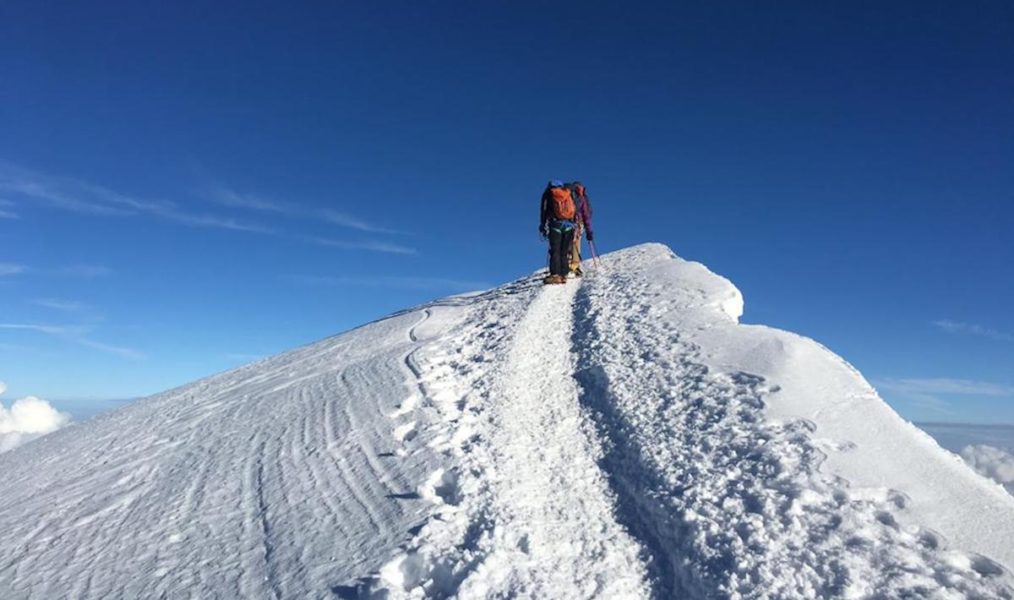You’d be excused for thinking this was a blog about Iceland, with a title of ‘Land of Rock and Fire’, but no, it’s a Chamonix and alpine conditions update!
The past months have been incredible for some routes, and there have been disasters in other areas. Never did it seem possible in our lifetimes to read headlines about the Arête des Cosmiques falling down, or the Grands Montets mid station destroyed by fire and closed for at least one year. Certainly it’s been a black year for the Chamonix lift company, but despite all the doom and gloom that has colonised the headlines, the late summer Alpine conditions were very good.
What marked this summer season out, was the exceptionally good weather throughout. It was rare to have more than one or two days poor weather in a week, so the mountains were busy. The small top ups of snow kept many routes in condition well into the summer. Some extra pressures on the Skyway lift above Courmayeur, were relieved when the Aiguille du Midi cable car reopened after replacing a main cable on its upper section, but after a busy few weeks of operation, it was suddenly closed again due to the new cable degrading faster than expected, and remaining closed for the remainder of summer. This closure coincided with major rockfalls in the Vallée Blanche basin, with Trident du Tacul Lepiney route collapsing, and a significant section of the lower part of the Arête des Cosmiques in the abseil sector also falling. Luckily in both rockfalls, no climbers were in the vicinity at the times, but obviously both sectors were effectively closed with advisories against approaching them.
Both these significant rockfalls were caused by the summer heatwave raising the permafrost level. At some stages this winter, during the Beast from the East, it seemed impossible that such changes could occur, but in reality the cold period was relatively short, and the global warming affecting the mountains has been occurring inexorably over many tens and hundreds of years. Other regions in the Alps were much less affected than the Mont Blanc massif, however the end of summer saw very dry glacier conditions almost everywhere, with some very icy final ascents of normally straightforward 4000m peaks, such as those in Saas, Arolla, Oberland and Gran Paradiso.
As the summer drew to a close, the Chamonix cable cars were hit with a series of breakdowns and mishaps. The Midi closed, then there were technical issues variously on the Brevent, Le Tour, and Flegere lifts at various stages. These paled into insignificance, when in the second week of September, the Lognan mid station of the Grands Montets burned to the ground, in a fire reportedly started by a contractor undertaking roof repairs at the time. As a result most of the cables melted, with the cable cars crashing to the ground. No one was in them at the time. The middle station is now a shell of twisted metal, reminiscent of a war zone. It will need to be completely removed and rebuilt, which in the long term is probably a blessing to upgrade this popular cable car to current and hopefully future-proof standards.
In more cheery news, the major mountain sporting events calendar in the Mont Blanc massif had a great year. The Ultra-Trail du Mont Blanc was a huge success, with record numbers of finishers due to largely perfect weather and conditions. This year the UTMB series added a new ‘mini’ race to its range, and the first edition of the MCC was run, from Martigny-Combe in Switzerland to Chamonix in France. This is just under a trail marathon in length, with 2300m of vertical. Xavier Thevenard won his third UTMB edition, with Francesca Canepa of Italy taking the women’s title. British runner Damian Hall ran exceptionally well, and took fifth place. Further across the Alps on the Ultra Trail Monte Rosa, running legend Nicky Spinks won the women’s race. On the 330km Tor des Geants in north Italy, Franco Colle took the title, and in the final Chamonix trail race of season, Nicholas Martin won the Trail des Aiguilles Rouges.
Mont Blanc ascents this year have received more publicity than usual on two fronts; the Saint Gervais mayor stating that permits are required for 2019 ascents, and celebrity ascents such as that of Richard Branson’s Strive team. The permit issue is an interesting one, in that nothing is really changing at all. Simply all climbers on the mountain will need to prove that they have a reservation in one of the mountain huts, and the reservation paperwork is in essence a permit. So how does this affect climbers? Most people climb Mont Blanc over two or even three days, so a booking in a mountain hut, such as the Refuge du Gouter, is normal already. The second half of the summer saw mountain rescue Gendarmes stationed near the Tête Rousse hut, checking those ascending further against a booking list supplied the the Gouter hut each day. The only people affected were effectively those who were breaking the law trying to camp higher up the mountain, who were stopped.
Most commercial guiding outfits only offer ascents when they have guaranteed space, so nothing changes. The key thing here is that this being advertised as a ‘permit’ is potentially a first step towards the mountain actually having a paid permit system. Many locals and climbers oppose these moves on two fronts; firstly it is a restriction on liberties, in that we go to the mountains for their freedom and to escape daily bureaucracy, and secondly this is monetising the mountains to no tangible benefit for them. Mont Blanc doesn’t stand in a national park, and so access is hard to regulate. Questions remain unanswered, such as who will really be impacted by these changes.
Potentially it will stop all climbers camping on the mountain, even next to the Tête Rousse where it is authorised, and the likes of Kilian Jornet who run up and down the mountain in a day will presumably be stopped as they have no hut booking. It would be amusing to watch someone try and run after Kilian to enforce this though! The ‘laws’ seem slightly Orwellian, in that they are virtually impossible to enforce, so “All animals are equal, but some animals are more equal than others.” Perhaps this is the best outcome, and the laws will be most harshly applied to those who need protecting from themselves, and a blind eye will be turned to those whose experience and commensurate level of safety is higher.
These moves come a year after the mayor of Saint Gervais brought in rules to enforce all alpinists carrying suitable equipment. He aimed to reduce the circus attitude on Mont Blanc, where ascents were made at all costs, with dangerous risks being taken. Who knows what the mayor’s blood pressure is at now, following the Virgin Strive team ascent with Richard Branson, who reportedly took a helicopter down from the summit. This follows a similar strategy on their previous ascent with Princess Eugenie in 2012, where a helicopter was also used for the descent. This is despite only helicopter rescues being permitted in France, not landing helicopters as taxis in the mountains. It certainly seems that the actions of some high profile celebrities, are impacting on the liberties that all of us currently enjoy in the mountains, and whilst their charities may be very worthwhile, the greater impact of their actions must be carefully considered.
It’s certainly interesting times in the mountains, watching the deep freeze of winter giving way to huge heatwaves and their impact, and the financial pressures of commercialisation and exploitation of the mountains. Previously I’d have been more blasé and stated something along the lines of the mountains surviving proud above these pressures, but now I’m not so sure. Literally the mountains are crumbling before our eyes, and more than ever Alpinists need to adapt to these changes in both the short and long term. The exceptionally good snowfalls of last winter protected the mountains from bigger changes this summer, so for now the hope is that this winter lays down its snowy mantle soon, to preserve the permafrost layer for a precious few extra weeks. As I write, the first snows of Autumn have already left a dusting on the summit of Mont Joly above Les Contamines, and the temperatures are dipping. Roll on winter, whatever you bring!
 Kingsley Jones is an International Mountain Leader and co-owner of Icicle Mountaineering. He’s also an author of mountain running books including ‘Lake District Trail & Fell Running’ and ‘Chamonix Trail Running’. More info at www.kingsleyjones.com
Kingsley Jones is an International Mountain Leader and co-owner of Icicle Mountaineering. He’s also an author of mountain running books including ‘Lake District Trail & Fell Running’ and ‘Chamonix Trail Running’. More info at www.kingsleyjones.com






